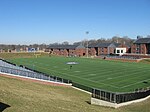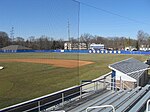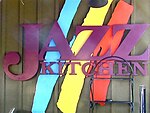Meridian Street United Methodist Church

Meridian Street United Methodist Church, known in its early years as Wesley Chapel, the Meridian Street Methodist Episcopal Church, and the Meridian Street Methodist Church, is a Methodist church located at 5500 North Meridian Street in Indianapolis, Indiana. The church originated from the first Methodist congregation in Indianapolis that began in a log cabin in 1821–22 with fifty members. The congregation worshipped at several locations and erected four earlier churches on Monument Circle and along Meridian Street in downtown Indianapolis before it merged with the Fifty-first Street Methodists in 1945. The first service at its North Meridian Street location was held on June 29, 1952. Designed by the architectural firm of Russ and Harrison, the Georgian-Colonial-style, red-brick church is noted for its architecture, pipe organ (one of the city’s largest), and formal parlor. The Aldersgate addition on the west side (rear) of the church was consecrated on October 4, 1989. The church conducts midweek and Sunday worship services in addition to its ongoing religious ministry and foreign missions. During its early years, the congregation was involved in the organization of Asbury University (present-day DePauw University) and Indianapolis's Methodist Hospital. The church’s membership reached its peak in 1965 at 2,571 members, but declined in subsequent decades as the city expanded. Notable members of the congregation include former U.S. Vice President Charles W. Fairbanks; Albert J. Beveridge, a two-term U.S. senator and Pulitzer Prize-winning author; James F. Hanly, a former Indiana governor and U.S. congressman; Mary Stewart Carey, founder of The Children's Museum of Indianapolis; Calvin Fletcher, an early Indianapolis citizen who helped found the city's public school system; and industrialists and philanthropists James I. Holcomb and Herman C. Krannert.
Excerpt from the Wikipedia article Meridian Street United Methodist Church (License: CC BY-SA 3.0, Authors, Images).Meridian Street United Methodist Church
North Meridian Street, Indianapolis Meridian Kessler
Geographical coordinates (GPS) Address Nearby Places Show on map
Geographical coordinates (GPS)
| Latitude | Longitude |
|---|---|
| N 39.85222 ° | E -86.15807 ° |
Address
Meridian Street United Methodist Church
North Meridian Street 5500
46208 Indianapolis, Meridian Kessler
Indiana, United States
Open on Google Maps









